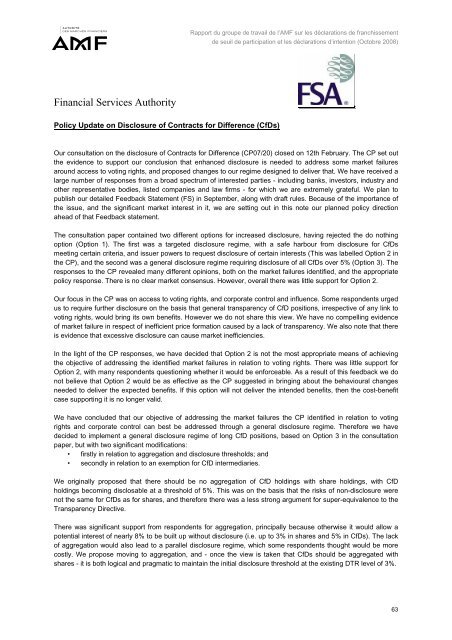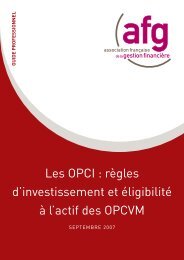Rapport sur les déclarations de franchissement de seuil de ... - AFG
Rapport sur les déclarations de franchissement de seuil de ... - AFG
Rapport sur les déclarations de franchissement de seuil de ... - AFG
Create successful ePaper yourself
Turn your PDF publications into a flip-book with our unique Google optimized e-Paper software.
Financial Services Authority<br />
Policy Update on Disclo<strong>sur</strong>e of Contracts for Difference (CfDs)<br />
<strong>Rapport</strong> du groupe <strong>de</strong> travail <strong>de</strong> l’AMF <strong>sur</strong> <strong>les</strong> <strong>déclarations</strong> <strong>de</strong> <strong>franchissement</strong><br />
<strong>de</strong> <strong>seuil</strong> <strong>de</strong> participation et <strong>les</strong> <strong>déclarations</strong> d’intention (Octobre 2008)<br />
Our consultation on the disclo<strong>sur</strong>e of Contracts for Difference (CP07/20) closed on 12th February. The CP set out<br />
the evi<strong>de</strong>nce to support our conclusion that enhanced disclo<strong>sur</strong>e is nee<strong>de</strong>d to address some market failures<br />
around access to voting rights, and proposed changes to our regime <strong>de</strong>signed to <strong>de</strong>liver that. We have received a<br />
large number of responses from a broad spectrum of interested parties - including banks, investors, industry and<br />
other representative bodies, listed companies and law firms - for which we are extremely grateful. We plan to<br />
publish our <strong>de</strong>tailed Feedback Statement (FS) in September, along with draft ru<strong>les</strong>. Because of the importance of<br />
the issue, and the significant market interest in it, we are setting out in this note our planned policy direction<br />
ahead of that Feedback statement.<br />
The consultation paper contained two different options for increased disclo<strong>sur</strong>e, having rejected the do nothing<br />
option (Option 1). The first was a targeted disclo<strong>sur</strong>e regime, with a safe harbour from disclo<strong>sur</strong>e for CfDs<br />
meeting certain criteria, and issuer powers to request disclo<strong>sur</strong>e of certain interests (This was labelled Option 2 in<br />
the CP), and the second was a general disclo<strong>sur</strong>e regime requiring disclo<strong>sur</strong>e of all CfDs over 5% (Option 3). The<br />
responses to the CP revealed many different opinions, both on the market failures i<strong>de</strong>ntified, and the appropriate<br />
policy response. There is no clear market consensus. However, overall there was little support for Option 2.<br />
Our focus in the CP was on access to voting rights, and corporate control and influence. Some respon<strong>de</strong>nts urged<br />
us to require further disclo<strong>sur</strong>e on the basis that general transparency of CfD positions, irrespective of any link to<br />
voting rights, would bring its own benefits. However we do not share this view. We have no compelling evi<strong>de</strong>nce<br />
of market failure in respect of inefficient price formation caused by a lack of transparency. We also note that there<br />
is evi<strong>de</strong>nce that excessive disclo<strong>sur</strong>e can cause market inefficiencies.<br />
In the light of the CP responses, we have <strong>de</strong>ci<strong>de</strong>d that Option 2 is not the most appropriate means of achieving<br />
the objective of addressing the i<strong>de</strong>ntified market failures in relation to voting rights. There was little support for<br />
Option 2, with many respon<strong>de</strong>nts questioning whether it would be enforceable. As a result of this feedback we do<br />
not believe that Option 2 would be as effective as the CP suggested in bringing about the behavioural changes<br />
nee<strong>de</strong>d to <strong>de</strong>liver the expected benefits. If this option will not <strong>de</strong>liver the inten<strong>de</strong>d benefits, then the cost-benefit<br />
case supporting it is no longer valid.<br />
We have conclu<strong>de</strong>d that our objective of addressing the market failures the CP i<strong>de</strong>ntified in relation to voting<br />
rights and corporate control can best be addressed through a general disclo<strong>sur</strong>e regime. Therefore we have<br />
<strong>de</strong>ci<strong>de</strong>d to implement a general disclo<strong>sur</strong>e regime of long CfD positions, based on Option 3 in the consultation<br />
paper, but with two significant modifications:<br />
• firstly in relation to aggregation and disclo<strong>sur</strong>e thresholds; and<br />
• secondly in relation to an exemption for CfD intermediaries.<br />
We originally proposed that there should be no aggregation of CfD holdings with share holdings, with CfD<br />
holdings becoming disclosable at a threshold of 5%. This was on the basis that the risks of non-disclo<strong>sur</strong>e were<br />
not the same for CfDs as for shares, and therefore there was a <strong>les</strong>s strong argument for super-equivalence to the<br />
Transparency Directive.<br />
There was significant support from respon<strong>de</strong>nts for aggregation, principally because otherwise it would allow a<br />
potential interest of nearly 8% to be built up without disclo<strong>sur</strong>e (i.e. up to 3% in shares and 5% in CfDs). The lack<br />
of aggregation would also lead to a parallel disclo<strong>sur</strong>e regime, which some respon<strong>de</strong>nts thought would be more<br />
costly. We propose moving to aggregation, and - once the view is taken that CfDs should be aggregated with<br />
shares - it is both logical and pragmatic to maintain the initial disclo<strong>sur</strong>e threshold at the existing DTR level of 3%.<br />
63



